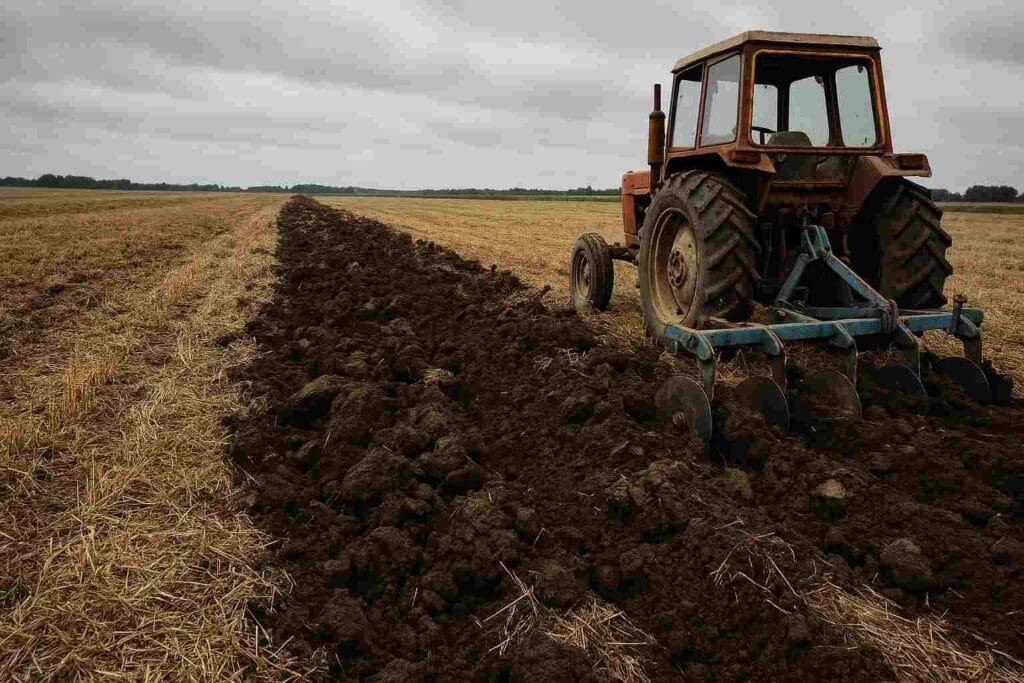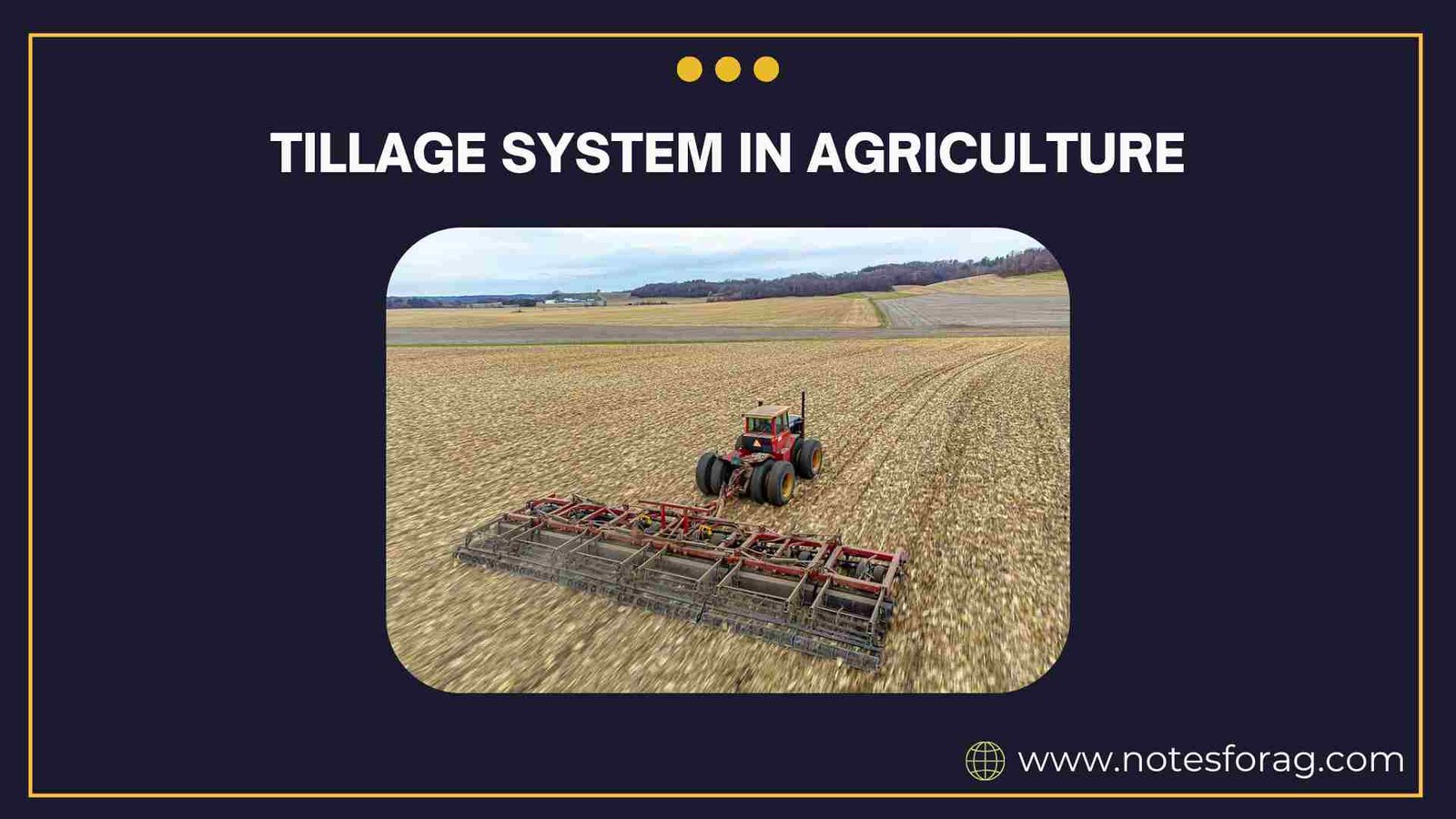A tillage system refers to the method and practice of preparing the soil for planting crops by mechanically turning, loosening, and aerating it. It involves different types of soil cultivation techniques aimed at improving soil structure, controlling weeds, and enhancing water infiltration and root growth for better crop production.

1. INTRODUCTION TO TILLAGE
Tillage is the essential agricultural practice that involves preparing the soil for planting crops by mechanical means such as digging, stirring, and overturning. It aims to create an ideal environment for seed sowing and healthy plant growth by improving soil aeration, moisture retention, and nutrient availability. Tillage breaks up compacted soil layers and helps control weeds and pests, which can otherwise reduce crop productivity. Over time, tillage has evolved from manual tools to advanced machinery, making it more efficient and widespread in modern farming. The choice of tillage system directly affects soil health and crop yield, making it a critical factor in agriculture.
SUMMARY OF TILLAGE SYSTEMS
- Tillage is the process of preparing soil for planting by mechanical means to improve aeration, moisture, and nutrient availability.
- Different tillage systems such as conventional, reduced, minimum, and zero tillage offer varied benefits and challenges based on soil and climate conditions.
- Modern trends favor conservation tillage to protect soil health, reduce erosion, and promote sustainable agriculture with the help of advanced machinery and technology.
Table of Contents
2. IMPORTANCE OF TILLAGE SYSTEM
Tillage is vital because it prepares the land to support robust plant growth. By loosening the soil, tillage improves aeration and water infiltration, which are necessary for roots to access oxygen and moisture. It also helps in weed control by uprooting or burying weed seeds, reducing competition for nutrients and water. Moreover, tillage incorporates organic matter such as crop residues and fertilizers into the soil, which enhances fertility. Overall, good tillage practices ensure a well-prepared seedbed, reduce crop failure risk, and increase agricultural productivity, especially in intensive farming systems.
3. TYPES OF TILLAGE SYSTEMS
The Types of Tillage systems are,
3.1 Conventional Tillage Systems
Conventional tillage is the traditional method that involves extensive soil disturbance through plowing and harrowing. It prepares a fine seedbed by completely turning over the soil, which buries weeds and residues. This method is effective in controlling pests and diseases and ensures proper seed-soil contact. However, it can also cause soil erosion, loss of organic matter, and soil structure degradation if practiced excessively.
3.2 Reduced Tillage
Reduced tillage limits soil disturbance compared to conventional tillage. It only partially turns the soil to conserve moisture and organic matter while still preparing the land for planting. This system reduces the risks of erosion and soil degradation, making it more sustainable. It requires careful management of weeds and crop residues.
3.3 Minimum Tillage
Minimum tillage involves the least soil disturbance necessary for planting seeds. It retains most of the crop residues on the surface, which protects the soil from erosion and helps maintain moisture. Minimum tillage helps preserve soil structure and microbial life, but farmers need to manage weeds and pests using herbicides or other methods.
3.4 Zero Tillage
Zero tillage, or no-till farming, is a system where seeds are sown directly into the undisturbed soil without any prior plowing. This system conserves soil moisture, improves soil health, and reduces labor and fuel costs. It encourages the buildup of organic matter and supports beneficial soil organisms. Zero tillage is widely promoted for sustainable agriculture, but it requires specialized seed drills and effective weed control strategies.
4. TOOLS AND EQUIPMENT USED IN TILLAGE SYSTEM
The tools and equipment used in Tillage System are,
4.1 Plow
The plow is the primary tool in tillage, used to cut, lift, and turn over the soil. It breaks the soil crust and buries crop residues, weeds, and pests. There are different types of plows such as the moldboard plow, chisel plow, and disc plow, each suited to different soil types and tillage needs.
4.2 Harrow
After plowing, the harrow is used to break soil clods, level the field, and create a fine seedbed. It can be spring-tooth, disc, or chain harrows. Harrowing smooths the soil surface and improves seed-to-soil contact for better germination.
4.3 Cultivator
Cultivators are used mainly for secondary tillage to loosen the soil and control weeds between crop rows. They stir the soil without completely turning it over, preserving the soil structure while maintaining aeration and moisture.
4.4 Rotavator

Rotavators are mechanized tillage tools with rotating blades that churn and mix the soil. They are efficient for seedbed preparation and can be used in various soil types. Rotavators reduce labor and speed up the tillage process.
5. OBJECTIVES OF TILLAGE SYSTEM
The primary objective of tillage is to prepare a favorable seedbed that promotes quick and uniform seed germination. It aims to improve soil aeration by loosening compacted layers, allowing roots to penetrate easily. Tillage helps control weeds by uprooting or burying them and destroys pest habitats in the soil. Additionally, tillage incorporates organic matter, fertilizers, and lime into the soil to enhance fertility. It also helps in moisture conservation by improving water infiltration and reducing runoff.
6. FACTORS AFFECTING TILLAGE SYSTEM
Several factors determine the choice and effectiveness of a tillage system. Soil type is critical since sandy soils require different tillage practices than heavy clay soils. Climate influences tillage timing and method because moisture levels affect soil workability. The type of crop being cultivated affects tillage decisions since some crops need deeper soil preparation. Topography also matters; steep slopes require minimal tillage to prevent erosion. The size of the farm and availability of mechanization impact which tillage system is feasible. Economic considerations such as labor costs, fuel prices, and equipment investment play a significant role in choosing the tillage system.
7. ADVANTAGES OF TILLAGE
Tillage offers multiple benefits, including improved soil aeration and better water infiltration. It helps control weeds, reducing the competition for nutrients and water. By mixing fertilizers and organic matter into the soil, tillage enhances soil fertility. It prepares a uniform seedbed that ensures good seed-soil contact for optimal germination. Tillage also aids in breaking down soil crusts, reducing runoff and promoting root growth. Moreover, proper tillage can reduce pest and disease incidence by destroying their habitats.
8. DISADVANTAGES OF TILLAGE
Despite its advantages, excessive tillage can have negative effects. It can lead to soil erosion by removing protective surface residues. Intensive tillage may degrade soil structure and reduce organic matter, harming soil fertility in the long run. Tillage can also compact the subsoil if done improperly, limiting root penetration and water movement. It disturbs beneficial soil organisms that help maintain soil health. Moreover, tillage requires significant labor and fuel, increasing production costs and environmental impact.

Tillage degrading the quality of soil.
9. MODERN TRENDS IN TILLAGE
Modern agriculture is moving towards conservation tillage practices like reduced tillage and zero tillage. These systems aim to minimize soil disturbance to conserve moisture and maintain soil health. Advances in technology have led to the development of specialized equipment for no-till farming. Precision agriculture uses GPS and sensors to optimize tillage operations, reducing input waste. Conservation tillage improves carbon sequestration and helps combat climate change. Governments and agricultural organizations are promoting sustainable tillage to ensure long-term productivity and environmental protection.
10. FUTURE PROSPECTS OF TILLAGE
The future of tillage lies in sustainable and climate-smart practices. Innovations in machinery and soil management will allow farmers to reduce tillage intensity while maintaining productivity. Organic farming and agroecological approaches emphasize minimal soil disturbance to protect biodiversity. Research is focusing on soil biology and carbon management to improve tillage outcomes. Digital tools will help farmers make data-driven decisions for efficient tillage. As awareness about environmental impacts grows, the adoption of conservation tillage is expected to increase globally, promoting resilient and profitable agriculture.
11. CONCLUSION
Tillage remains a fundamental practice in agriculture that significantly influences soil health, crop productivity, and sustainable farming. By preparing the soil for planting, tillage improves aeration, moisture retention, and nutrient availability, all of which are critical for healthy crop growth. Different tillage systems, ranging from conventional to zero tillage, offer farmers various options based on their soil type, climate, and economic conditions. While conventional tillage helps in thorough soil preparation and weed control, it can also lead to soil erosion and loss of organic matter if overused. On the other hand, modern trends such as reduced and zero tillage prioritize conservation of soil structure, moisture, and beneficial organisms, making farming more sustainable and environmentally friendly.
Advances in mechanization and precision agriculture are further enhancing the efficiency and effectiveness of tillage practices. However, it is essential to balance the benefits of tillage with its environmental impact by adopting practices that protect soil health and reduce erosion. Looking ahead, the future of tillage lies in embracing sustainable techniques that support soil biodiversity, conserve resources, and help mitigate climate change effects. By integrating traditional knowledge with innovative technology, farmers can achieve productive, resilient, and eco-friendly agricultural systems. Therefore, tillage remains a dynamic field that adapts to the evolving challenges of food security and environmental conservation.
Frequently Asked Questions (FAQs)
What is tillage system?
A tillage system is the method of preparing soil for planting by mechanically turning, loosening, and aerating it. It helps improve soil structure, control weeds, and support crop growth.
What is the best tillage system?
The best tillage system depends on soil type and climate, but conservation tillage like zero tillage is often preferred for preserving soil health, reducing erosion, and saving moisture.
What are the types of tillage system?
The main types of tillage systems are conventional tillage, reduced tillage, minimum tillage, and zero tillage, each varying in the degree of soil disturbance and conservation practices.
Related Articles

